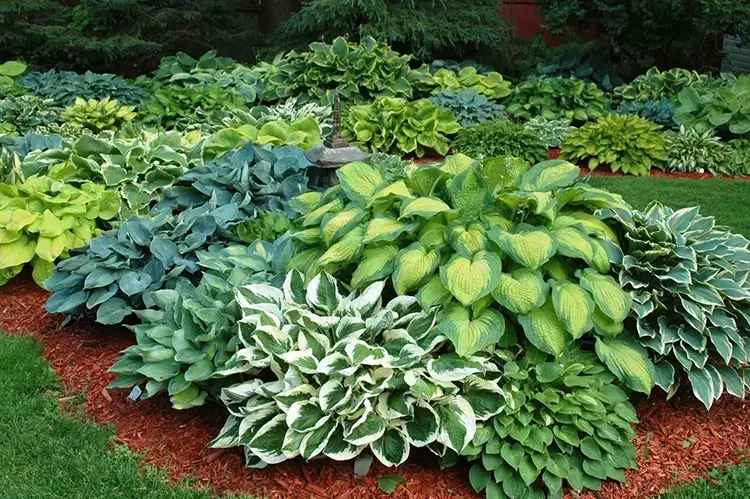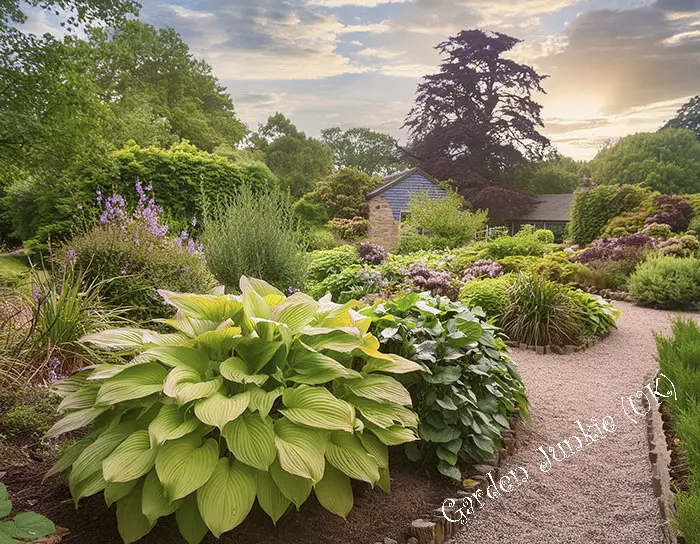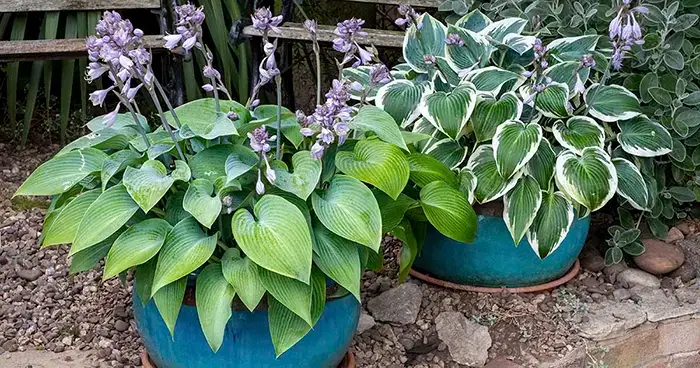Beautiful Plants For Your Interior
Hosta Plant: A Comprehensive Guide to Growing and Caring for Hostas

Hosta plants are a popular choice for gardeners looking to add some greenery to the shady side of their gardens. With their lush foliage and easy-to-care-for nature, Hostas are a great addition to any landscape. In this post, we’ll take a closer look at Hosta plants.
Hostas from the family Asparagaceae are a type of perennial plant that is native to Asia. They are known for their large, broad leaves, which come in a variety of colours and patterns. Hostas are a great choice for shady areas of the garden, as they thrive in low-light conditions. They are also easy to care for, making them a popular choice for gardeners of all skill levels.
Best Sellers List – Hostas
Last update on 2025-12-12
If you’re interested in adding Hostas to your garden, there are a few things you need to know. First, you’ll need to choose the right variety of Hosta for your needs. There are dozens of different Hosta varieties to choose from, each with its unique characteristics. You’ll also need to know how to plant and care for your Hostas, including how much water and fertiliser they need, and how to deal with common pests and diseases.
Key Takeaways
- Understanding the different varieties of Hosta plants
- Essential tips for planting and soil preparation
- Effective methods for watering and fertilising
- Common pests and diseases affecting Hosta plants
Hosta plants are available in a wide variety of species and cultivars, each with unique characteristics that make them suitable for different garden settings. In this part of the post, we will explore some of the different types of Hosta plants and help you choose the right one for your garden.
Hosta Plant: There are Many, Many Varieties of Hosta Plants to Suit Everybody’s Needs
Species and Cultivars
Hosta plants are classified into different species, each with its own unique characteristics. Some of the most common species of Hosta plants include ‘Plantain Lilies’ (Hosta plantaginea), Hosta sieboldiana, Hosta lancifolia, and Hosta ventricosa. These species are further divided into cultivars, which are selected for their unique features such as leaf colour, texture, and size.
Unique Characteristics of Different Hosta Types
Hosta plants come in a variety of leaf shapes, colours, and textures. Green leaves are the most common, but variegated leaves with white or yellow markings are also popular. Hosta leaves can be smooth or ruffled, and some cultivars have leaves with a unique texture, such as the ‘Sum and Substance‘ cultivar, which has large, puckered leaves.
Choosing the Right Hosta for Your Garden
When choosing a Hosta plant for your garden, consider the size of your garden, the amount of shade it receives, and the look you want to achieve. If you have a small garden, choose a compact cultivar such as ‘Blue Mouse Ears‘ or ‘Pandora’s Box’. If you have a large garden, consider a larger cultivar such as ‘Empress Wu‘ or ‘Sum and Substance‘.
If you want to create a ‘focal point’ in your garden, choose a cultivar with unique characteristics such as the ‘June‘ cultivar, which has blue-green leaves with a gold centre. If you want to create a ‘natural’ look, choose a mix of cultivars with different leaf shapes and textures.
We can see, Hosta plants are a versatile addition to any garden. With a wide variety of species and cultivars available, there is a Hosta plant to suit every garden setting. By considering the size of your garden, the amount of shade it receives, and the look you want to achieve, you can choose the perfect Hosta plant for your garden.
Planting Hosta Plants
Hostas are shade-loving plants that are primarily grown for their beautiful foliage. They are easy to plant and care for once they have become established in the soil. In this part of our post, we will discuss the ‘best time’ to plant Hostas, soil preparation, and a step-by-step planting guide.
The Best Time to Plant Hostas
The best time to plant Hostas is in the Spring after the last frost has passed. This will give the plants enough time to establish themselves before the hot summer months. However, Hostas can also be planted in the Autumn, about 4-6 weeks before the first frost.
Soil Preparation and Requirements
Hostas prefer a pH range of around 6.5–7.5, which is slightly acidic to slightly alkaline They also require well-draining soil that is rich in organic matter. Before planting, it is important to prepare the soil by removing any weeds, rocks, or debris. You can also add compost or well-rotted manure to the soil to improve its fertility.
Step-by-Step Planting Guide
- Choose a planting location that offers ‘partial’ shade, as too much sun can cause the leaves to scorch. Hostas can also be planted in full shade, but they may not grow as large or produce as many leaves.
- Dig a hole that is twice the size of the ‘root ball’ and about as deep as the container you bought it in. Make sure to space the plants about 18-24 in (45-60cm) apart.
- Gently remove the plant from its container and loosen the roots if they are tightly bound. If the plant is bare-root, soak the roots in water for a few hours before planting.
- Place the plant in the hole and backfill with soil, making sure to firm the soil around the plant to remove any air pockets.
- Water the plant thoroughly after planting and keep the soil moist but not waterlogged. mulching around the plant can help retain moisture and suppress weeds.
Planting Hostas is an easy and rewarding process that can add beauty and interest to your garden. By following these simple ‘planting’ steps above, you can ensure that your Hostas thrive and provide years of enjoyment.

Hosta Plants Make Great Focal Points in Any Garden
Watering and Fertilising Hostas
Hostas are shade-loving plants that require consistent watering and fertilisation to thrive. In this part of our post, we’ll cover how often to water Hostas, types of fertilisers suitable for Hostas, and tips for fertilising throughout the growing season.
How Often to Water Hostas
Hostas prefer ‘moist’ soil not ‘wet’ soil and do not tolerate drought well. In the Summer months, you should aim to water your Hostas at least once a week, and more frequently during periods of hot, dry weather. It’s important to avoid overwatering, as this can lead to ‘root rot’ and other fungal diseases. To check if your Hostas need watering, stick your finger into the soil around the plant. If the soil feels dry to the touch, it’s time to water.
Types of Fertilisers Suitable for Hostas
Hostas benefit from regular fertilisation to promote healthy growth and vibrant foliage. When selecting a fertiliser for your Hostas, look for a balanced, slow-release formula that contains nitrogen, phosphorus, and potassium (NPK). You can also use organic fertilisers such as compost or well-rotted manure. Apply fertiliser in the Spring and again in mid-summer, following the manufacturer’s instructions for dosage and application.
Tips for Fertilising Throughout the Growing Season
To keep your Hostas looking their best throughout the growing season, follow these tips for fertilising:
- In the Spring, apply a slow-release fertiliser to the soil around the base of the plant.
- As the plant begins to grow, side-dress with a balanced fertiliser every 4-6 weeks.
- Once the plant begins to bloom, reduce the amount of fertiliser you apply, as the plant will focus its energy on producing flowers and seeds.
- In the Autumn, stop fertilising your Hostas to allow the plant to prepare for dormancy.
Remember that fertilising is just one part of caring for your Hostas. Be sure to also provide adequate water, proper planting, and regular maintenance such as dividing and cutting back dead foliage. By following these tips, you can enjoy healthy, vibrant Hostas year after year.
Pests and Diseases
Hostas are generally low-maintenance plants, but they can still be affected by pests and diseases. Here are some common issues you may encounter with your Hostas, and what you can do about them.
Common Pests That Affect Hostas
Hostas are susceptible to a range of pests, including slugs, snails, aphids, and cutworms. Slugs and snails are perhaps the most common problem, and they can cause significant damage to Hosta leaves. To combat these pests, you can use a range of methods, including copper tape, eggshells, and beer traps. You can also use pellets, but be sure to follow the instructions carefully and keep them away from pets and children.
Aphids can cause leaves to curl and distort. You can remove them by spraying your Hostas with a strong jet of water or by using insecticidal soap. Cutworms cause significant damage to young Hostas. You can prevent them by using collars made from cardboard or plastic around the base of your plants.
Identifying and Treating Diseases in Hosta Plants
Hostas can also be affected by a range of diseases, including fungal infections and bacterial infections. One of the most common diseases is ‘leaf spot’, which causes ‘brown or black’ spots on the leaves. To prevent leaf spot, be sure to water your hostas at the base of the plant and avoid getting water on the leaves. If you do notice signs of leaf spot, you can remove the affected leaves and use a fungicide to prevent the disease from spreading.
Another common disease is ‘crown rot’, which can cause your Hostas to wilt and die. To prevent crown rot, be sure to plant your Hostas in well-draining soil and avoid over-watering them. If you do notice signs of crown rot, you should remove the affected plants and dispose of them to prevent the disease from spreading.
Preventative Measures to Protect Your Hostas
To recap on keeping your Hostas healthy and free from pests and diseases, remember a few preventative measures you can take. First, be sure to care for your Hostas properly by providing them with adequate water, mulch, and compost. You should also fertilise your Hostas regularly to ensure they have the nutrients they need to thrive.
In addition, you should ‘cut back’ any dead foliage and remove any debris from around your Hostas to prevent pests and diseases from taking hold. Finally, you can use organic matter, such as compost or well-rotted manure, to improve the health of your soil and keep your Hostas strong and healthy.
Seasonal Care for Hostas
Hostas are low-maintenance plants that require little attention throughout the year. However, some seasonal care can help them thrive and stay healthy. Here are some tips on how to care for your Hostas throughout the seasons.
Spring Care Tips
In the Spring, Hostas start to emerge from dormancy. This is the time to remove any debris or dead leaves that may have accumulated around the plants over the winter. Rake away any mulch that was used for winter protection to allow the developing ‘eye/s’ (growing shoot/s that emerges from the crown of a Hosta plant in early spring) to emerge. Once the eyes have emerged, apply fresh mulch around the plants, but keep it away from the centre crown to prevent ‘crown rot’.
Spring is also the time to ‘divide’ and transplant Hostas. If the ‘clumps’ are overcrowded or the plants have outgrown their space, it’s time to divide them. Hostas can be divided in either Spring or Autumn. To divide, dig up the entire clump and separate the individual plants with a sharp knife or spade. Replant the divided plants in a well-drained soil mixture, and water thoroughly.
Summer Maintenance
During the summer months, Hostas require little maintenance. However, it’s important to keep them well-watered, especially during periods of drought. Water your Hostas deeply once a week, rather than shallowly every day. This will encourage deep root growth and help the plants withstand dry periods.
Slugs and snails as mentioned can be a problem during the Summer months especially. To protect your Hostas from these pests, follow the tips we recommended earlier.
Preparing Hostas for Winter
As Autumn approaches, it’s important to prepare your Hostas for the winter months. Cut back any dead foliage and remove any debris around the plants. This will help prevent pests and diseases from overwintering in the plant debris.
In areas with harsh winters, it’s a good idea to mulch around the plants with a layer of straw or leaves to provide extra insulation. This will help protect the plants from frost heave, which can damage the roots. Mulching will also help regulate soil temperature and moisture levels.

Hosta Plants Can Also be Grown in Pots
Landscaping with Hostas
Hostas are versatile plants that can add a touch of green to any garden. Incorporating Hostas into your garden design is easy as they come in a wide range of shapes, sizes, and colours. They can be used as ground cover, as borders, or as ‘focal points’ in your garden. Here are some tips on how to landscape with Hostas.
Incorporating Hostas Into Your Garden Design
When incorporating Hostas into your garden design, consider the colours of the Hosta leaves. Hostas come in a variety of colours including green, blue, yellow, white, and purple. Choose Hostas with colours that complement your garden’s colour scheme. Hostas can also be used to add texture to your garden. Hostas with corrugated leaves or variegated leaves can add a unique texture to your garden.
Hostas are also great for container gardening. Choose a container that is large enough to accommodate the Hosta’s root system. Hostas prefer well-drained soil, so make sure your container has drainage holes. When planting Hostas in containers, use good quality potting soil and fertilise regularly.
Companion Plants For Hostas
Hostas can be paired with a variety of companion plants to create a beautiful garden. Some great companion plants for Hostas include ferns, heuchera, dicentra, pulmonaria, astilbes, hydrangeas, azaleas, bleeding heart, and perennial geraniums. These plants complement Hostas and provide a beautiful contrast in your garden.
Creative Landscaping Ideas Using Hostas
Hostas can be used in a variety of creative landscaping ideas. For example, you can create a Hosta walkway by planting Hostas on either side of a garden path. You can also create a Hosta border by planting Hostas along the edge of your garden. Why not choose a large Hosta with unique leaves and plant it in a ‘prominent’ location in your garden?
To round up, Hostas are versatile plants that can add beauty and texture to any garden. By incorporating Hostas into your garden design and pairing them with complementary plants, you can create a beautiful and unique garden that you can enjoy for years to come.
FAQ’s
How much sunlight do hosta plants need?
Hostas prefer partial to full shade, but some varieties can tolerate more sunlight.
What type of soil is best for hosta plants?
Hostas thrive in well-draining soil that is rich in organic matter.
How do I divide hosta plants?
Divide hostas in early spring or fall by digging up the clump and separating the roots.
When is the best time to plant hostas?
The best time to plant hostas is in early spring or autumn when the weather is cooler.
Conclusion
Congratulations on successfully growing your Hosta plants! With proper care and maintenance, your Hostas will continue to thrive for many years to come.
In the Spring and Summer months, be sure to water your Hostas regularly and keep the soil consistently moist but not waterlogged. Applying a 2-3in (50-75mm) layer of organic mulch, such as shredded bark or leaf mould, around the base of the plant will help retain moisture and suppress weed growth.
During the winter months, it is important to lift and protect your Hostas to ensure their survival.
Overall, Hostas are a beautiful and resilient plant that can add a touch of elegance to any garden. By following our simple guidelines, you can enjoy a stunning display of foliage year after year.
